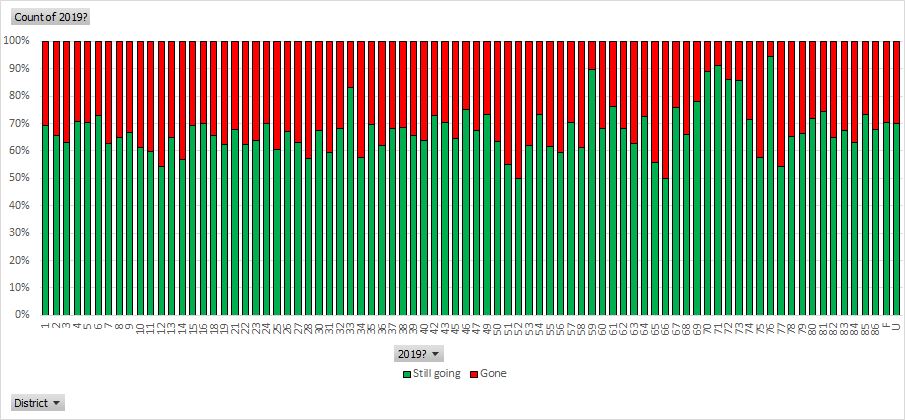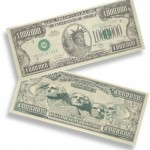The 2019 990 tax return for Toastmasters International has been released. Total revenue was down 9.2%, and expenses were down 1.8%. Total salaries were up 0.2% (35% of all expenses, up slightly from 34% in 2018), even though the number of employees is down from 236 to 198 (down 16%).
Expenses and vendors
- Payroll (including all related expenses, like benefits and pensions) was by far the largest single expense, at $13.4M (about the same as 2018).
- District expenses were $9.7M (up 11%).
- The magazine cost $2.7M (down 4%).
- Depreciation added up to $1.4M (unchanged).
- Insurance was $1.2M (unchanged).
- Software cost $1.4M (up 17% from $1.2M; this may or may not include Cornerstone, as they’re a vendor).
- Transportation (apparently different from “travel”) cost $976K (down 1.3% from $1.1M).
- Travel was $1.2M (up 19% from $1.0M).
Expenditures on club-building and leadership training by world (not TM) region are interesting, it does cost significantly more to support members outside of North America.
- North America, $902K (up from $832K previous year)
- East Asia/Pacific, $1,986K (was $1,998K)
- Europe, $827K (up from $595K)
- Middle East/North Africa: $678K (up considerably from $461K)
- Central America/Caribbean: $84K ($79K)
- Sub-Saharan Africa: $387K ($329K)
- South America: $21K ($6K, reflecting new growth there)
- South Asia: $576K (up considerably from $306K)
The five largest vendors for Toastmasters were:
- RR Donnelley & Sons, $5.4M for logistics (up from $5.1M last year, most TI store sales)
- Integrated Interiors & Construction, $1.1M (presumably WHQ construction)
- Cornerstone Ondemand, $822K (up from $660K, the Pathways web site)
- Hyatt Regency Paris, $541K (to be the 2020 convention site)
- Freeman Audio Visual, $284K (was $617K, convention A/V)
22 more companies were paid at least $100K (each) in 2019.
Employee compensation
Staff paid over $100K/year must be reported (per U.S. non-profit tax law), listed below.
- CEO Dan Rex, $396K base compensation (7.7% decrease) plus a $120K bonus (30% of base), for $552K total compensation (3.8% decrease)
- Chief financial officer John Bond, $280K (1% increase in base salary)
- Chief information officer Hamidreza (Sam) Farajian, $326K total comp (3% increase in base salary)
- Controller Margaret Yamamoto, $206K (base salary up 21%)
- Application services IT director Nader Hariri, $186K (up 3%)
- Cloud services manager Albert Hadiprodjo, $164K (new to the list)
- HR director Gary Kinser, $173K (new to the list)
- Marketing director John Lurquin, $152K (new to the list)
- Marketing director William Nissim, $338K (up from $240K, includes $74K in other compensation, likely a termination package)
- Member engagement officer Darci Maenpa, $296K (up 35%)
The CEO’s compensation was established using a compensation board committee, the form 990 tax returns from other organizations, a written employment contract, a compensation study or survey, and approval by the board or compensation committee (per the tax return, Schedule J). (The tax form includes one other method for determining compensation which is not used by TI, an independent compensation consultant.)
Expenses did include paying for first-class or charter travel, travel for companions, and tax indemnification/gross-up payments (per the tax return), following a written reimbursement policy, and requiring substantiation of expenses.
Revenue and assets
Total program revenue grew by 5.0%, to a total of $39.7M. The Toastmasters district conferences globally took in $3.7M in revenue (up 15%). The annual convention in Denver pulled in $1.0M (down 17% from Chicago in 2018). For materials sold, the sales revenue only covered half the cost, resulting in a 47% loss on sales. In 2018, the loss was 51%, while in 2017, there was an 6.8% loss.
Total assets grew by 3.8%, to $54.9M, of which $25.4M is cash and investments, equal to 0.65 years of expenses (up from 0.63 years in 2018, 0.52 years in 2017, 0.56 years in 2016, and 1.2 years in 2015), below the range of the recommendation for non-profits to have 1-2 years of expenses saved up in reserves. The land and building at WHQ is valued at a net of $26.4M (up 1.9%). Inventory has decreased by another 13% (after decreasing by 13% in 2018), to $602K.
Net assets grew by $1.5M (3.7%), mostly due to prepaid expenses growing by $1M and investments growing by $882K (other smaller shifts canceled some of this out).
Related organizations
Three organizations are identified as related, “Toastmasters International Singapore Ltd”,“Toastmasters International (Hong Kong) Ltd”, and “Shenzen Toastmasters Culture Exchange”, all companies for “legal and compliance administration” (also controlled by TI).
Click here for the full 2019 tax return.
2018 tax return analysis
2017 tax return analysis
2016 tax return analysis
2015 tax return analysis
2014 tax return analysis
2013 tax return analysis
2012 tax return analysis
2011 tax return analysis
 The 2018 990 tax return for Toastmasters International has been released. Total revenue was up 10.0%, and expenses were down 4.0%. Total salaries were down 12.9% (34% of all expenses, down from 37% in 2017), even though the number of employees is up from 181 to 236 (up 30%, partly a recovery from staff loss during the Denver move the previous year).
The 2018 990 tax return for Toastmasters International has been released. Total revenue was up 10.0%, and expenses were down 4.0%. Total salaries were down 12.9% (34% of all expenses, down from 37% in 2017), even though the number of employees is up from 181 to 236 (up 30%, partly a recovery from staff loss during the Denver move the previous year). 




 The annual Toastmasters business meeting is where we elect the board of directors, international officers, and amend our governing documents.
The annual Toastmasters business meeting is where we elect the board of directors, international officers, and amend our governing documents.
